Financial Accounting Principles Report: Application and Analysis
VerifiedAdded on 2021/01/03
|29
|4156
|52
Report
AI Summary
This report provides a comprehensive overview of financial accounting principles, regulations, and their practical application. It begins by defining financial accounting and its purpose, followed by an examination of relevant regulations, accounting rules, and conventions. The report then delves into practical examples, including journal entries, ledger accounts, cash books, and trial balances, using various client scenarios to illustrate key concepts. It covers the preparation of income statements, financial statements, profit and loss accounts, and statements of financial position. Additionally, the report addresses accounting concepts such as prudency and consistency, the purpose of depreciation, and bank reconciliation. It also explores control accounts, suspense accounts, and the importance of these elements in ensuring accurate financial reporting. The report concludes with a summary of the main points and provides a list of references.

FINANCIAL ACCOUNTING
PRINCIPLES
PRINCIPLES
Paraphrase This Document
Need a fresh take? Get an instant paraphrase of this document with our AI Paraphraser
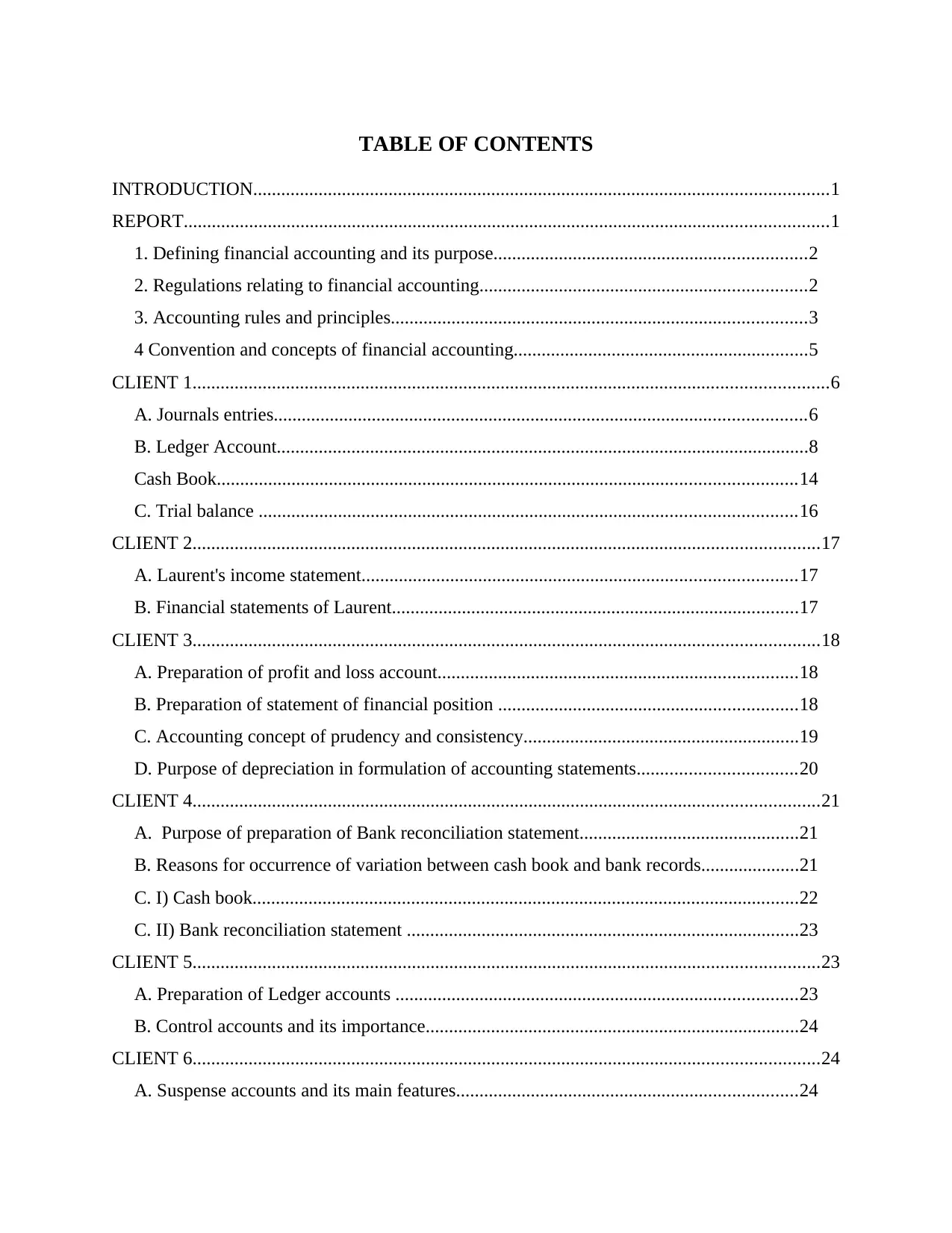
TABLE OF CONTENTS
INTRODUCTION...........................................................................................................................1
REPORT..........................................................................................................................................1
1. Defining financial accounting and its purpose...................................................................2
2. Regulations relating to financial accounting......................................................................2
3. Accounting rules and principles.........................................................................................3
4 Convention and concepts of financial accounting...............................................................5
CLIENT 1........................................................................................................................................6
A. Journals entries..................................................................................................................6
B. Ledger Account..................................................................................................................8
Cash Book............................................................................................................................14
C. Trial balance ...................................................................................................................16
CLIENT 2......................................................................................................................................17
A. Laurent's income statement.............................................................................................17
B. Financial statements of Laurent.......................................................................................17
CLIENT 3......................................................................................................................................18
A. Preparation of profit and loss account.............................................................................18
B. Preparation of statement of financial position ................................................................18
C. Accounting concept of prudency and consistency...........................................................19
D. Purpose of depreciation in formulation of accounting statements..................................20
CLIENT 4......................................................................................................................................21
A. Purpose of preparation of Bank reconciliation statement...............................................21
B. Reasons for occurrence of variation between cash book and bank records.....................21
C. I) Cash book.....................................................................................................................22
C. II) Bank reconciliation statement ....................................................................................23
CLIENT 5......................................................................................................................................23
A. Preparation of Ledger accounts ......................................................................................23
B. Control accounts and its importance................................................................................24
CLIENT 6......................................................................................................................................24
A. Suspense accounts and its main features.........................................................................24
INTRODUCTION...........................................................................................................................1
REPORT..........................................................................................................................................1
1. Defining financial accounting and its purpose...................................................................2
2. Regulations relating to financial accounting......................................................................2
3. Accounting rules and principles.........................................................................................3
4 Convention and concepts of financial accounting...............................................................5
CLIENT 1........................................................................................................................................6
A. Journals entries..................................................................................................................6
B. Ledger Account..................................................................................................................8
Cash Book............................................................................................................................14
C. Trial balance ...................................................................................................................16
CLIENT 2......................................................................................................................................17
A. Laurent's income statement.............................................................................................17
B. Financial statements of Laurent.......................................................................................17
CLIENT 3......................................................................................................................................18
A. Preparation of profit and loss account.............................................................................18
B. Preparation of statement of financial position ................................................................18
C. Accounting concept of prudency and consistency...........................................................19
D. Purpose of depreciation in formulation of accounting statements..................................20
CLIENT 4......................................................................................................................................21
A. Purpose of preparation of Bank reconciliation statement...............................................21
B. Reasons for occurrence of variation between cash book and bank records.....................21
C. I) Cash book.....................................................................................................................22
C. II) Bank reconciliation statement ....................................................................................23
CLIENT 5......................................................................................................................................23
A. Preparation of Ledger accounts ......................................................................................23
B. Control accounts and its importance................................................................................24
CLIENT 6......................................................................................................................................24
A. Suspense accounts and its main features.........................................................................24

B and C. Preparation of Trial Balance making correction ..................................................25
D. Differentiation between clearing and suspense account .................................................26
CONCLUSION..............................................................................................................................26
REFERENCES..............................................................................................................................27
D. Differentiation between clearing and suspense account .................................................26
CONCLUSION..............................................................................................................................26
REFERENCES..............................................................................................................................27
⊘ This is a preview!⊘
Do you want full access?
Subscribe today to unlock all pages.

Trusted by 1+ million students worldwide
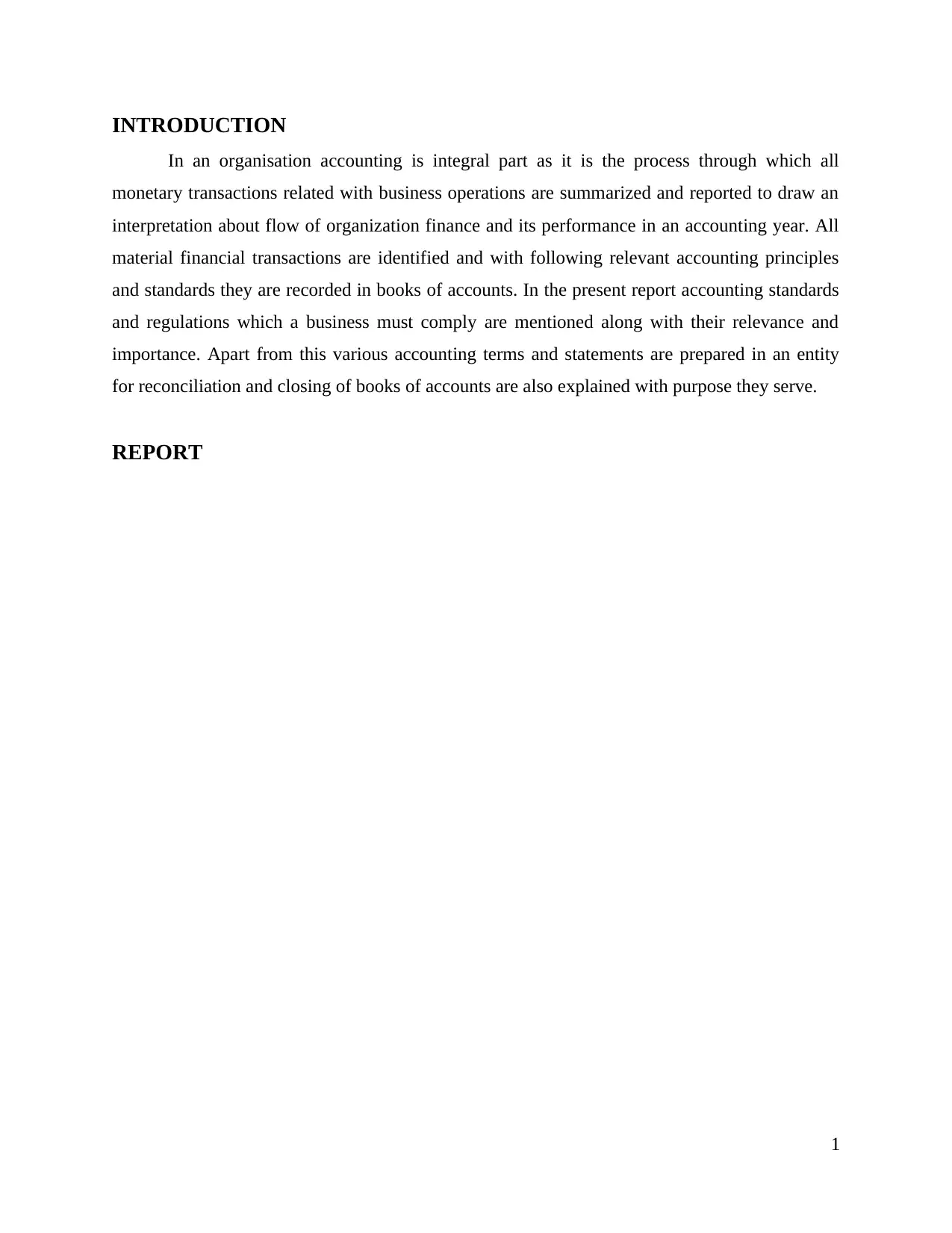
INTRODUCTION
In an organisation accounting is integral part as it is the process through which all
monetary transactions related with business operations are summarized and reported to draw an
interpretation about flow of organization finance and its performance in an accounting year. All
material financial transactions are identified and with following relevant accounting principles
and standards they are recorded in books of accounts. In the present report accounting standards
and regulations which a business must comply are mentioned along with their relevance and
importance. Apart from this various accounting terms and statements are prepared in an entity
for reconciliation and closing of books of accounts are also explained with purpose they serve.
REPORT
1
In an organisation accounting is integral part as it is the process through which all
monetary transactions related with business operations are summarized and reported to draw an
interpretation about flow of organization finance and its performance in an accounting year. All
material financial transactions are identified and with following relevant accounting principles
and standards they are recorded in books of accounts. In the present report accounting standards
and regulations which a business must comply are mentioned along with their relevance and
importance. Apart from this various accounting terms and statements are prepared in an entity
for reconciliation and closing of books of accounts are also explained with purpose they serve.
REPORT
1
Paraphrase This Document
Need a fresh take? Get an instant paraphrase of this document with our AI Paraphraser
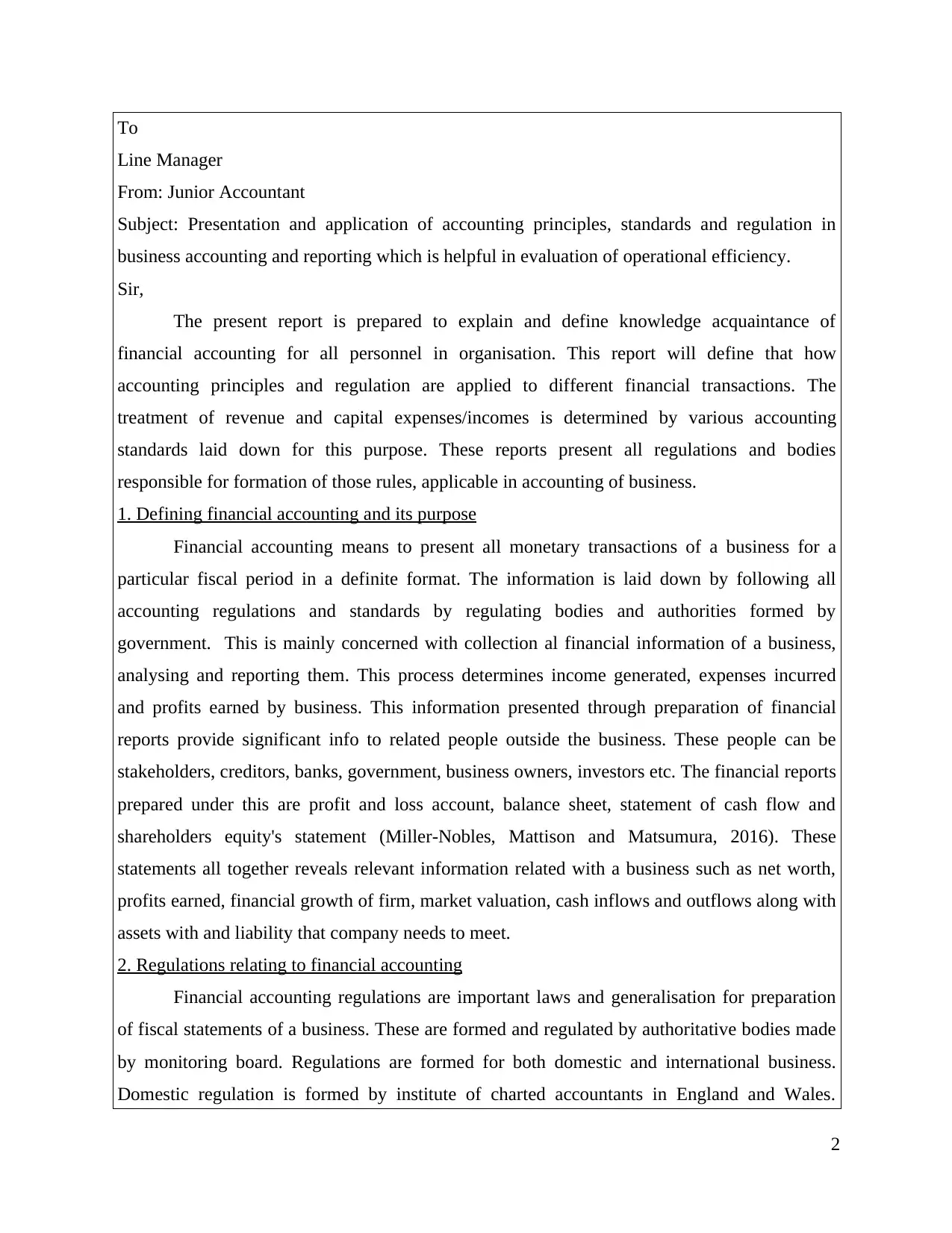
To
Line Manager
From: Junior Accountant
Subject: Presentation and application of accounting principles, standards and regulation in
business accounting and reporting which is helpful in evaluation of operational efficiency.
Sir,
The present report is prepared to explain and define knowledge acquaintance of
financial accounting for all personnel in organisation. This report will define that how
accounting principles and regulation are applied to different financial transactions. The
treatment of revenue and capital expenses/incomes is determined by various accounting
standards laid down for this purpose. These reports present all regulations and bodies
responsible for formation of those rules, applicable in accounting of business.
1. Defining financial accounting and its purpose
Financial accounting means to present all monetary transactions of a business for a
particular fiscal period in a definite format. The information is laid down by following all
accounting regulations and standards by regulating bodies and authorities formed by
government. This is mainly concerned with collection al financial information of a business,
analysing and reporting them. This process determines income generated, expenses incurred
and profits earned by business. This information presented through preparation of financial
reports provide significant info to related people outside the business. These people can be
stakeholders, creditors, banks, government, business owners, investors etc. The financial reports
prepared under this are profit and loss account, balance sheet, statement of cash flow and
shareholders equity's statement (Miller-Nobles, Mattison and Matsumura, 2016). These
statements all together reveals relevant information related with a business such as net worth,
profits earned, financial growth of firm, market valuation, cash inflows and outflows along with
assets with and liability that company needs to meet.
2. Regulations relating to financial accounting
Financial accounting regulations are important laws and generalisation for preparation
of fiscal statements of a business. These are formed and regulated by authoritative bodies made
by monitoring board. Regulations are formed for both domestic and international business.
Domestic regulation is formed by institute of charted accountants in England and Wales.
2
Line Manager
From: Junior Accountant
Subject: Presentation and application of accounting principles, standards and regulation in
business accounting and reporting which is helpful in evaluation of operational efficiency.
Sir,
The present report is prepared to explain and define knowledge acquaintance of
financial accounting for all personnel in organisation. This report will define that how
accounting principles and regulation are applied to different financial transactions. The
treatment of revenue and capital expenses/incomes is determined by various accounting
standards laid down for this purpose. These reports present all regulations and bodies
responsible for formation of those rules, applicable in accounting of business.
1. Defining financial accounting and its purpose
Financial accounting means to present all monetary transactions of a business for a
particular fiscal period in a definite format. The information is laid down by following all
accounting regulations and standards by regulating bodies and authorities formed by
government. This is mainly concerned with collection al financial information of a business,
analysing and reporting them. This process determines income generated, expenses incurred
and profits earned by business. This information presented through preparation of financial
reports provide significant info to related people outside the business. These people can be
stakeholders, creditors, banks, government, business owners, investors etc. The financial reports
prepared under this are profit and loss account, balance sheet, statement of cash flow and
shareholders equity's statement (Miller-Nobles, Mattison and Matsumura, 2016). These
statements all together reveals relevant information related with a business such as net worth,
profits earned, financial growth of firm, market valuation, cash inflows and outflows along with
assets with and liability that company needs to meet.
2. Regulations relating to financial accounting
Financial accounting regulations are important laws and generalisation for preparation
of fiscal statements of a business. These are formed and regulated by authoritative bodies made
by monitoring board. Regulations are formed for both domestic and international business.
Domestic regulation is formed by institute of charted accountants in England and Wales.
2
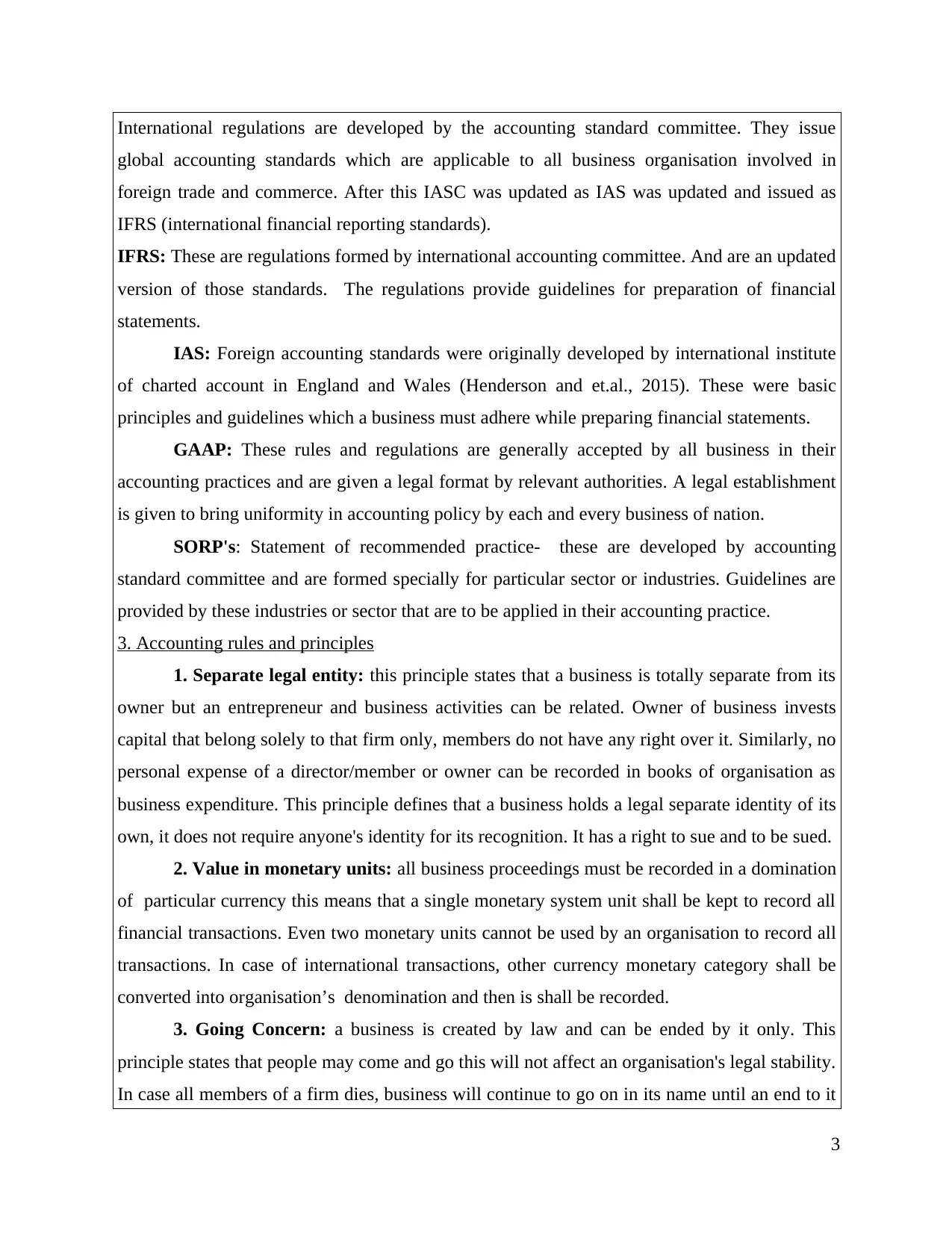
International regulations are developed by the accounting standard committee. They issue
global accounting standards which are applicable to all business organisation involved in
foreign trade and commerce. After this IASC was updated as IAS was updated and issued as
IFRS (international financial reporting standards).
IFRS: These are regulations formed by international accounting committee. And are an updated
version of those standards. The regulations provide guidelines for preparation of financial
statements.
IAS: Foreign accounting standards were originally developed by international institute
of charted account in England and Wales (Henderson and et.al., 2015). These were basic
principles and guidelines which a business must adhere while preparing financial statements.
GAAP: These rules and regulations are generally accepted by all business in their
accounting practices and are given a legal format by relevant authorities. A legal establishment
is given to bring uniformity in accounting policy by each and every business of nation.
SORP's: Statement of recommended practice- these are developed by accounting
standard committee and are formed specially for particular sector or industries. Guidelines are
provided by these industries or sector that are to be applied in their accounting practice.
3. Accounting rules and principles
1. Separate legal entity: this principle states that a business is totally separate from its
owner but an entrepreneur and business activities can be related. Owner of business invests
capital that belong solely to that firm only, members do not have any right over it. Similarly, no
personal expense of a director/member or owner can be recorded in books of organisation as
business expenditure. This principle defines that a business holds a legal separate identity of its
own, it does not require anyone's identity for its recognition. It has a right to sue and to be sued.
2. Value in monetary units: all business proceedings must be recorded in a domination
of particular currency this means that a single monetary system unit shall be kept to record all
financial transactions. Even two monetary units cannot be used by an organisation to record all
transactions. In case of international transactions, other currency monetary category shall be
converted into organisation’s denomination and then is shall be recorded.
3. Going Concern: a business is created by law and can be ended by it only. This
principle states that people may come and go this will not affect an organisation's legal stability.
In case all members of a firm dies, business will continue to go on in its name until an end to it
3
global accounting standards which are applicable to all business organisation involved in
foreign trade and commerce. After this IASC was updated as IAS was updated and issued as
IFRS (international financial reporting standards).
IFRS: These are regulations formed by international accounting committee. And are an updated
version of those standards. The regulations provide guidelines for preparation of financial
statements.
IAS: Foreign accounting standards were originally developed by international institute
of charted account in England and Wales (Henderson and et.al., 2015). These were basic
principles and guidelines which a business must adhere while preparing financial statements.
GAAP: These rules and regulations are generally accepted by all business in their
accounting practices and are given a legal format by relevant authorities. A legal establishment
is given to bring uniformity in accounting policy by each and every business of nation.
SORP's: Statement of recommended practice- these are developed by accounting
standard committee and are formed specially for particular sector or industries. Guidelines are
provided by these industries or sector that are to be applied in their accounting practice.
3. Accounting rules and principles
1. Separate legal entity: this principle states that a business is totally separate from its
owner but an entrepreneur and business activities can be related. Owner of business invests
capital that belong solely to that firm only, members do not have any right over it. Similarly, no
personal expense of a director/member or owner can be recorded in books of organisation as
business expenditure. This principle defines that a business holds a legal separate identity of its
own, it does not require anyone's identity for its recognition. It has a right to sue and to be sued.
2. Value in monetary units: all business proceedings must be recorded in a domination
of particular currency this means that a single monetary system unit shall be kept to record all
financial transactions. Even two monetary units cannot be used by an organisation to record all
transactions. In case of international transactions, other currency monetary category shall be
converted into organisation’s denomination and then is shall be recorded.
3. Going Concern: a business is created by law and can be ended by it only. This
principle states that people may come and go this will not affect an organisation's legal stability.
In case all members of a firm dies, business will continue to go on in its name until an end to it
3
⊘ This is a preview!⊘
Do you want full access?
Subscribe today to unlock all pages.

Trusted by 1+ million students worldwide

is put by following procedure of law that is dissolution or liquidation.
4. Historical cost: this means assets of a business must be valued on its acquisition cost
not at prevailing market rate, as it does not provide actual value of assets as it fluctuates with
inflation and deflation of economy (Beatty and Liao, 2014). So this principle makes action that
all assets are recorded in balance sheet as its original cost, which will present true and actual net
worth and financial position of business.
5. Accrual basis: record transaction pertaining to a business as and when they occur
irrespective of the fact of actual cash flow. This means a revenue when earned shall be booked
in books of business though amount related with it will be received on a later date or is received
in advance, same is case with expenses. Book a transaction as when it happens though cash is
received or paid in the future.
6. Matching principle: this principle states that a dual accounting system has to be
followed by a business. This means for every income there shall be an expense and vice a versa.
This means for expenses incurred income generation shall be showed.
7. Accounting period: Accounting period means a particular time period for which
financial accounts of an organisation are prepared. This preparation can be monthly, quarterly
or annually. Generally, time frame which is followed is annual. All statements reflecting
financial position of business are for a year which can start from either January, March or
September.
8. Relevance and reliability: all data and information recorded in books of accounts
must be relevant and reliable. Relevancy can be determined as all financial transaction books
must belong to that particular year and involves cash flow. Reliability of a transaction can be
checked to prove its authenticity all documentary evidences are available.
9. Conservatism: sometimes accounting transactions and other events are uncertain
and for maintaining relevancy they have to be reported in time. Estimation are made for
making judgement to deal with such uncertainty.
10. Comparability: this is a key quality which must be possessed by accounting
information. A comparison of such data can be carried out when accounting-standards and
polices are applied consistently from one period to other.
4 Convention and concepts of financial accounting
Consistency: once a method is adopted for recording financial transaction it must be
4
4. Historical cost: this means assets of a business must be valued on its acquisition cost
not at prevailing market rate, as it does not provide actual value of assets as it fluctuates with
inflation and deflation of economy (Beatty and Liao, 2014). So this principle makes action that
all assets are recorded in balance sheet as its original cost, which will present true and actual net
worth and financial position of business.
5. Accrual basis: record transaction pertaining to a business as and when they occur
irrespective of the fact of actual cash flow. This means a revenue when earned shall be booked
in books of business though amount related with it will be received on a later date or is received
in advance, same is case with expenses. Book a transaction as when it happens though cash is
received or paid in the future.
6. Matching principle: this principle states that a dual accounting system has to be
followed by a business. This means for every income there shall be an expense and vice a versa.
This means for expenses incurred income generation shall be showed.
7. Accounting period: Accounting period means a particular time period for which
financial accounts of an organisation are prepared. This preparation can be monthly, quarterly
or annually. Generally, time frame which is followed is annual. All statements reflecting
financial position of business are for a year which can start from either January, March or
September.
8. Relevance and reliability: all data and information recorded in books of accounts
must be relevant and reliable. Relevancy can be determined as all financial transaction books
must belong to that particular year and involves cash flow. Reliability of a transaction can be
checked to prove its authenticity all documentary evidences are available.
9. Conservatism: sometimes accounting transactions and other events are uncertain
and for maintaining relevancy they have to be reported in time. Estimation are made for
making judgement to deal with such uncertainty.
10. Comparability: this is a key quality which must be possessed by accounting
information. A comparison of such data can be carried out when accounting-standards and
polices are applied consistently from one period to other.
4 Convention and concepts of financial accounting
Consistency: once a method is adopted for recording financial transaction it must be
4
Paraphrase This Document
Need a fresh take? Get an instant paraphrase of this document with our AI Paraphraser
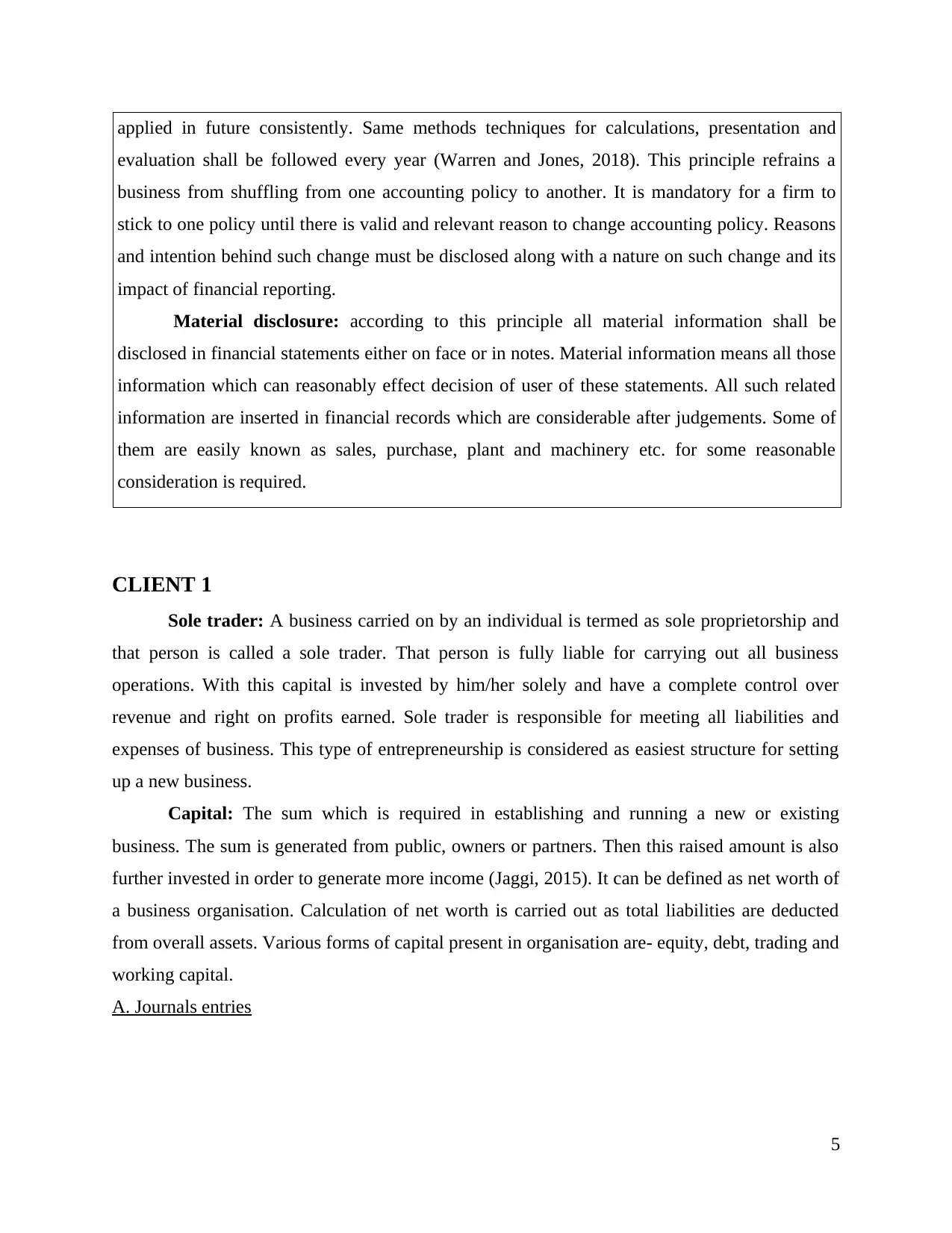
applied in future consistently. Same methods techniques for calculations, presentation and
evaluation shall be followed every year (Warren and Jones, 2018). This principle refrains a
business from shuffling from one accounting policy to another. It is mandatory for a firm to
stick to one policy until there is valid and relevant reason to change accounting policy. Reasons
and intention behind such change must be disclosed along with a nature on such change and its
impact of financial reporting.
Material disclosure: according to this principle all material information shall be
disclosed in financial statements either on face or in notes. Material information means all those
information which can reasonably effect decision of user of these statements. All such related
information are inserted in financial records which are considerable after judgements. Some of
them are easily known as sales, purchase, plant and machinery etc. for some reasonable
consideration is required.
CLIENT 1
Sole trader: A business carried on by an individual is termed as sole proprietorship and
that person is called a sole trader. That person is fully liable for carrying out all business
operations. With this capital is invested by him/her solely and have a complete control over
revenue and right on profits earned. Sole trader is responsible for meeting all liabilities and
expenses of business. This type of entrepreneurship is considered as easiest structure for setting
up a new business.
Capital: The sum which is required in establishing and running a new or existing
business. The sum is generated from public, owners or partners. Then this raised amount is also
further invested in order to generate more income (Jaggi, 2015). It can be defined as net worth of
a business organisation. Calculation of net worth is carried out as total liabilities are deducted
from overall assets. Various forms of capital present in organisation are- equity, debt, trading and
working capital.
A. Journals entries
5
evaluation shall be followed every year (Warren and Jones, 2018). This principle refrains a
business from shuffling from one accounting policy to another. It is mandatory for a firm to
stick to one policy until there is valid and relevant reason to change accounting policy. Reasons
and intention behind such change must be disclosed along with a nature on such change and its
impact of financial reporting.
Material disclosure: according to this principle all material information shall be
disclosed in financial statements either on face or in notes. Material information means all those
information which can reasonably effect decision of user of these statements. All such related
information are inserted in financial records which are considerable after judgements. Some of
them are easily known as sales, purchase, plant and machinery etc. for some reasonable
consideration is required.
CLIENT 1
Sole trader: A business carried on by an individual is termed as sole proprietorship and
that person is called a sole trader. That person is fully liable for carrying out all business
operations. With this capital is invested by him/her solely and have a complete control over
revenue and right on profits earned. Sole trader is responsible for meeting all liabilities and
expenses of business. This type of entrepreneurship is considered as easiest structure for setting
up a new business.
Capital: The sum which is required in establishing and running a new or existing
business. The sum is generated from public, owners or partners. Then this raised amount is also
further invested in order to generate more income (Jaggi, 2015). It can be defined as net worth of
a business organisation. Calculation of net worth is carried out as total liabilities are deducted
from overall assets. Various forms of capital present in organisation are- equity, debt, trading and
working capital.
A. Journals entries
5

6
⊘ This is a preview!⊘
Do you want full access?
Subscribe today to unlock all pages.

Trusted by 1+ million students worldwide
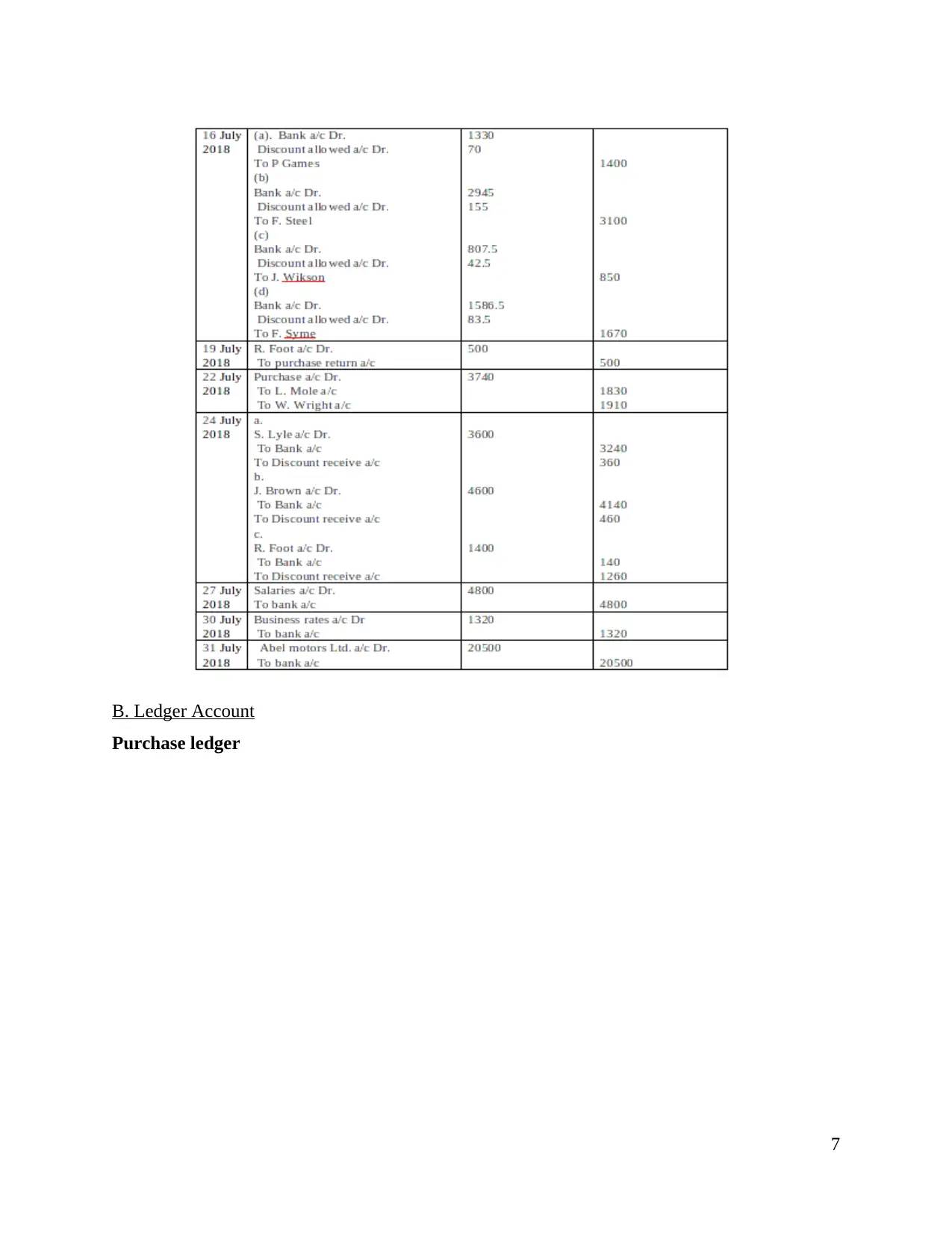
B. Ledger Account
Purchase ledger
7
Purchase ledger
7
Paraphrase This Document
Need a fresh take? Get an instant paraphrase of this document with our AI Paraphraser
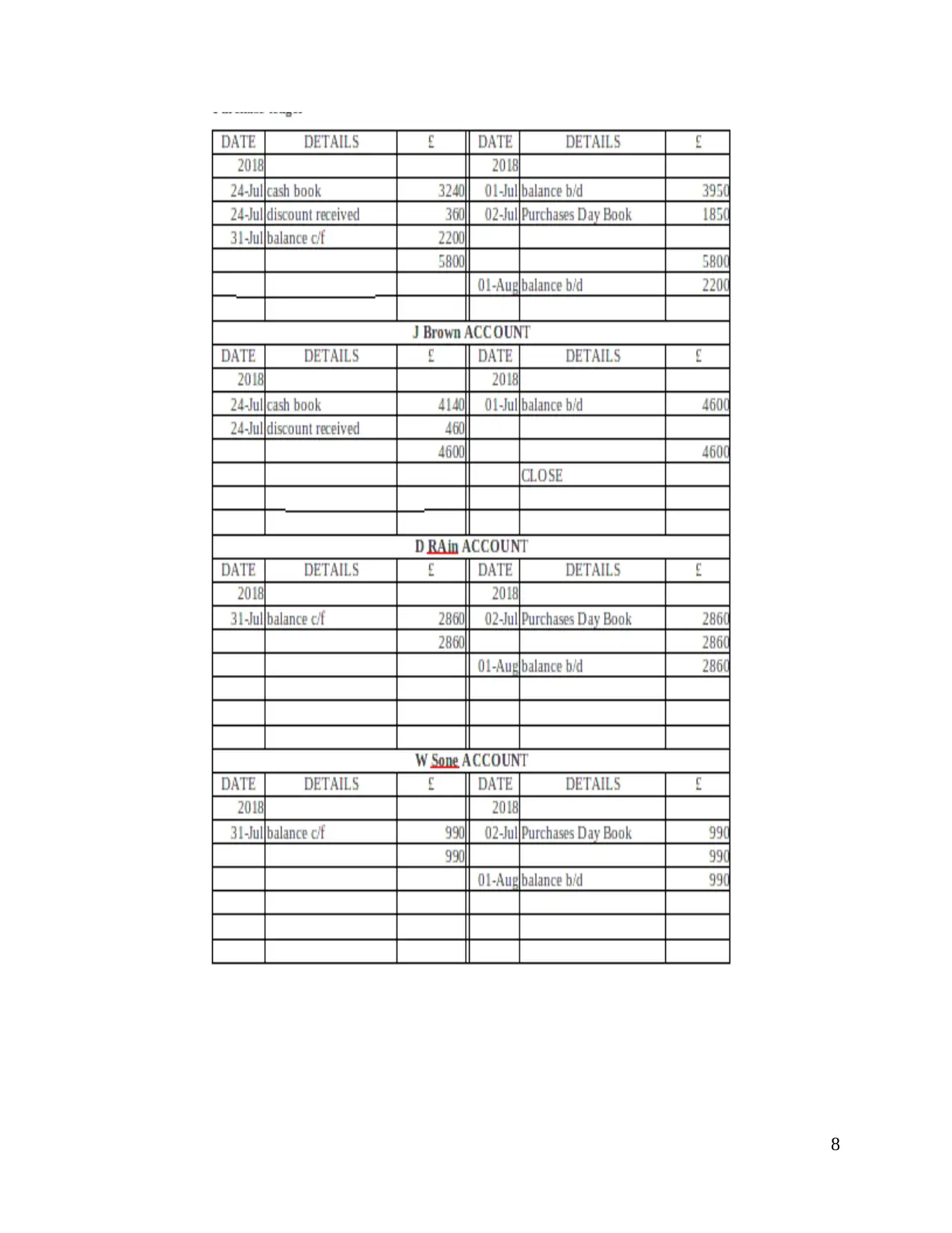
8
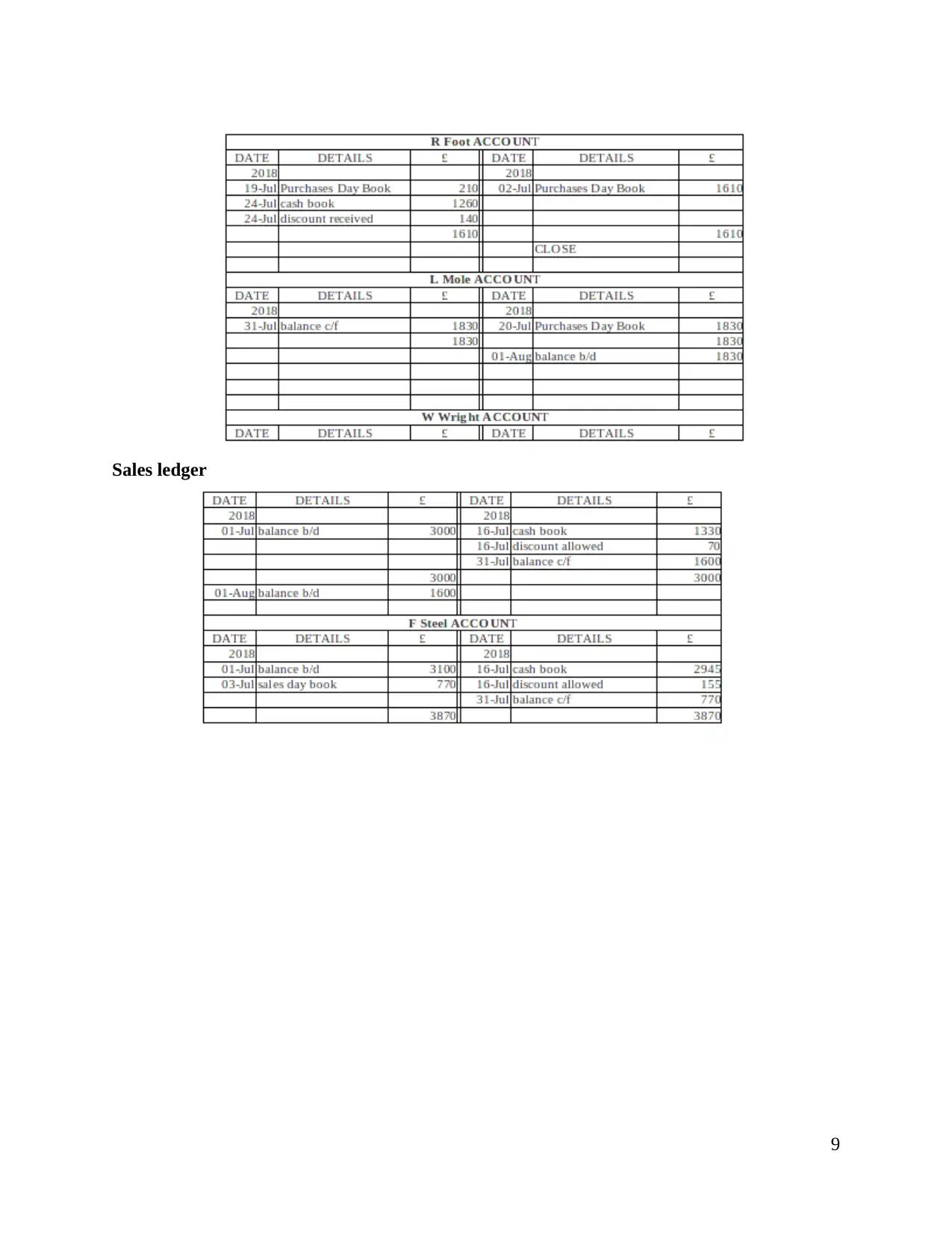
Sales ledger
9
9
⊘ This is a preview!⊘
Do you want full access?
Subscribe today to unlock all pages.

Trusted by 1+ million students worldwide
1 out of 29
Related Documents
Your All-in-One AI-Powered Toolkit for Academic Success.
+13062052269
info@desklib.com
Available 24*7 on WhatsApp / Email
![[object Object]](/_next/static/media/star-bottom.7253800d.svg)
Unlock your academic potential
Copyright © 2020–2025 A2Z Services. All Rights Reserved. Developed and managed by ZUCOL.





